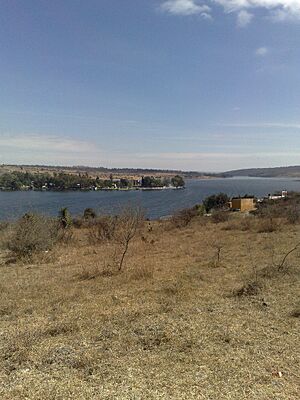Hueyatlaco facts for kids
Hueyatlaco is an important archaeological site in Mexico. It's located near the city of Puebla, in an area called the Valsequillo Basin. In the 1960s, scientists found amazing things here. They found signs that humans lived in Hueyatlaco about 25,000 years ago!
These findings were very surprising and caused a lot of discussion. Most scientists believe that humans first came to the Americas much later, around 13,000 to 16,000 years ago. So, the discoveries at Hueyatlaco suggest that people might have been here much, much earlier. This makes Hueyatlaco a very interesting and debated place in archaeology.
Contents
Digging Up the Past
The first team to dig at Hueyatlaco started in 1962. It was led by a scientist named Cynthia Irwin-Williams. Another scientist, Virginia Steen-McIntyre, later joined the team in 1966. She became well-known for sharing the findings from the site. The digging was done with help from the U.S. Geological Survey, which studies the Earth.
The area around Hueyatlaco was already famous for having many animal fossils. Irwin-Williams thought Hueyatlaco was a "kill site." This means it was a place where ancient people hunted animals and prepared them for food.
The scientists followed careful rules when digging. They found many stone tools at the site. Some tools were simple, while others were more advanced. They found things like scrapers and sharp blades. These tools were made from different types of stone, which suggests that many groups of people might have used this area over a long time.
How Old Is It?
In 1969, the scientists published their first report about dating the site. They found stone tools right next to animal bones. They used different methods to figure out how old these things were.
One method, called radiocarbon dating, suggested the animal remains were over 35,000 years old. Another method, called uranium dating, gave an age of about 260,000 years! These numbers were very different and confusing. The scientists weren't sure why the results were so different.
Solving the Mystery of the Dates
In 1973, Virginia Steen-McIntyre and other team members went back to Hueyatlaco. They wanted to understand the different layers of earth and get a more accurate age for the tools. They studied volcanic ash and rock from the site.
Using a method called Fission track dating, they dated ash samples to about 370,000 years ago. This was an incredibly old date for human activity in the Americas. This very old age caused disagreements among the scientists. Some thought the findings were valid, even if they were surprising. Others, like Irwin-Williams, felt the dating methods weren't accurate enough yet.
The Big Debate
For several years, the scientists discussed how to share their findings. Steen-McIntyre and others believed the 250,000-year-old dates were correct. But Irwin-Williams thought the site was much younger, around 20,000 years old. This disagreement made it hard to publish a final report on the site for a long time.
In 1981, a scientific journal called Quaternary Research finally published a paper by Steen-McIntyre and her colleagues. This paper supported the idea that humans lived at Hueyatlaco a very long time ago.
They used four different dating methods:
- Uranium-thorium dating
- Fission track dating
- Tephra hydration dating (dating volcanic ash)
- Studying how mineral weathering (rocks breaking down) happened over time
All these tests pointed to an age of about 250,000 years for the tools found at Hueyatlaco. The scientists knew this was a huge surprise for the archaeological world. They wrote that their findings should make other scientists think more openly about when humans first arrived in the Americas.
What Happened Next?
The findings from Hueyatlaco continued to be debated. Some scientists argued that the stone tools found were "too modern" to have been made by humans from 250,000 years ago. They also said the animal fossils found were from animals that lived much more recently, around 18,000 to 20,000 years ago.
However, other researchers have continued to study Hueyatlaco. In 2004 and 2006, a scientist named Sam VanLandingham published studies. He looked at tiny fossils called diatoms in the soil. His research also suggested the site was very old, confirming the dates of around 80,000 to 220,000 years ago.
In 2008, another scientist, Joseph Liddicoat, presented new research. He studied the magnetic properties of the volcanic ash at Hueyatlaco. His findings suggested the ash was even older, from sometime after 780,000 years ago.
The Hueyatlaco site remains a puzzle. It challenges what we thought we knew about early humans in the Americas. Scientists continue to study the evidence and debate its meaning.
See also
 In Spanish: Hueyatlaco para niños
In Spanish: Hueyatlaco para niños
- Xalnene Tuff footprints
- Cerutti Mastodon site


